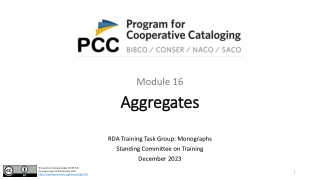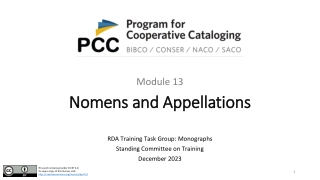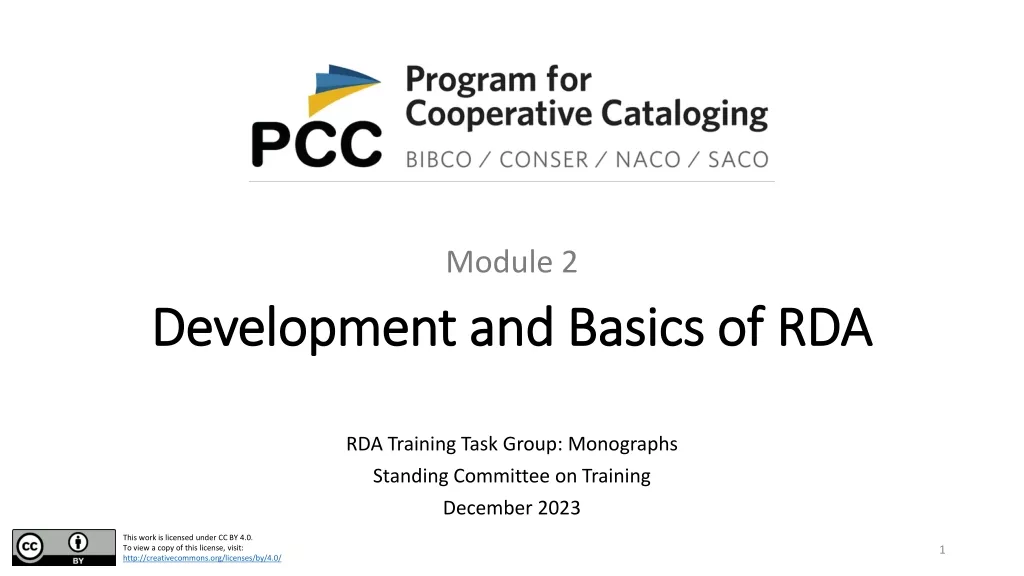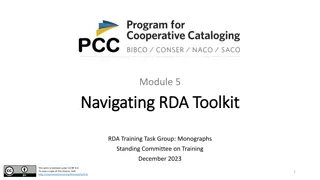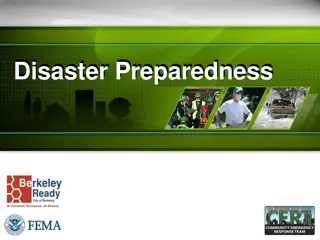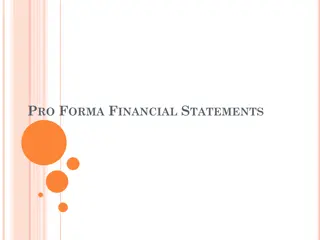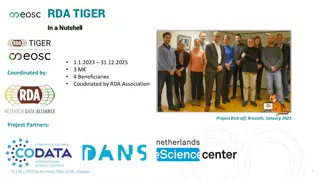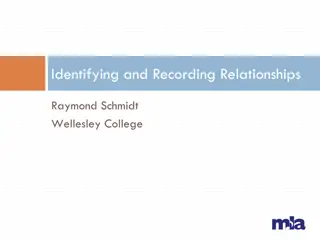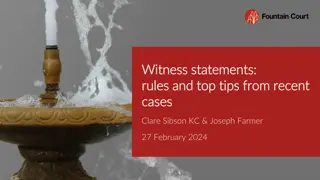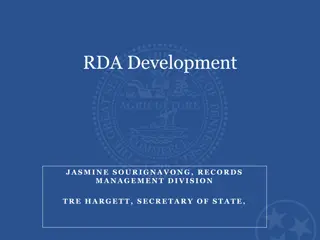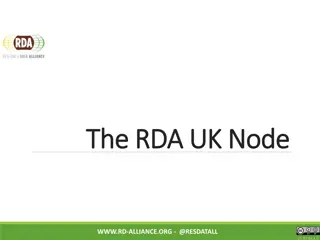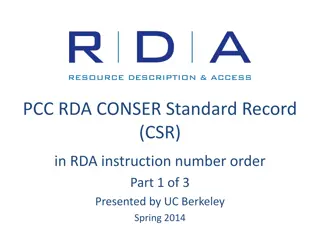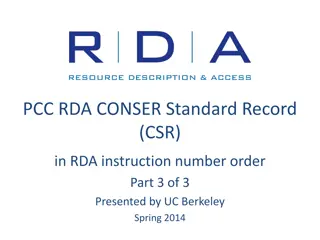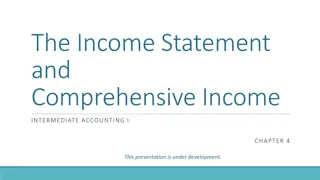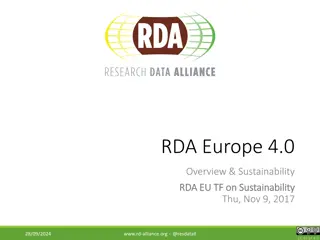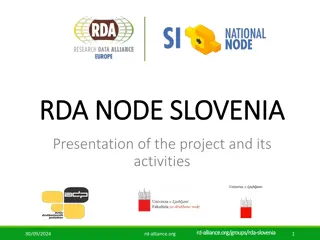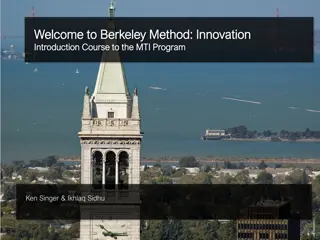Understanding BSR, RDA, and UC Berkeley Policy Statements
Learn how to apply the BSR (PCC Core) and UC Berkeley Policy Statements to describe print textual monographs, find RDA instructions and Policy Statements, distinguish differences between AACR2 rules and RDA instructions, and exercise judgment in reviewing RDA copy for the local catalog. Acronyms such as BSR, LC-PCC PS, UCB PS, WEMI, PFC, and AAP are explained, along with covered topics like general guidelines, identifying manifestations and items, describing carriers, and more.
Download Presentation

Please find below an Image/Link to download the presentation.
The content on the website is provided AS IS for your information and personal use only. It may not be sold, licensed, or shared on other websites without obtaining consent from the author. Download presentation by click this link. If you encounter any issues during the download, it is possible that the publisher has removed the file from their server.
E N D
Presentation Transcript
PCC RDA BIBCO Standard Record (BSR) in RDA instruction number order Part 2 of 2 Presented by UC Berkeley Fall/Winter 2013/14
Days 3-4 Learning Objectives Apply the BSR (PCC Core) and UC Berkeley Policy Statements to describe print textual monographs (non-rare) Find RDA instructions and Policy Statements for PCC Core elements within the RDA Toolkit Distinguish substantive differences between AACR2 rules and RDA instructions (plus local guidelines) for PCC Core elements Exercise appropriate judgment when reviewing existing RDA copy for inclusion in the local catalog @ UCB 2
Acronyms BSR = BIBCO Standard Record Library of Congress Program for Coop. Cat. Policy Statement (RDA equiv. of LCRI) UC Berkeley Policy Statement (local policy) Work, Expression, Manifestation, Item (FRBR Group 1 entities) Person, Family, Corporate body (FRBR Group 2 entities) Authorized Access Point (RDA equiv. of heading ) LC-PCC PS = UCB PS = WEMI = PFC = AAP = @ UCB 3
Where have we been? Covered in Part 1 Chapter 1: General Guidelines on Recording Attributes of Manifestations and Items (focus on transcription and numbers/numerals) Chapter 2: Identifying Manifestations and Items @ UCB 4
Where are we going? To be covered in Part 2 today Chapter 3: Describing Carriers A tiny bit of Chapter 6: Identifying Works and Expressions (will be covered fully on Day 5) Chapter 7: Describing Content Section 6: Recording Relationships to Persons, Families, and Corporate Bodies (resource Section 8: Recording Relationships between Works, Expressions, Manifestations, and Items (resource resource) PFC) @ UCB 5
What is a Carrier? Carrier is the physical thing may be tangible or digital Then what is Content? information, data, art, etc. In other words: Content is whatever is being communicated Carrieris the package it comes in Notice that: Carrier is in Section 1 (Manifestation & Item) Content is in Section 2 (Work & Expression) @ UCB 6
Why are we getting rid of GMD? Terms are a mixed bag of carrier and content microform = carrier cartographic material = content electronic resource = carrier, sort of (what equipment do you need?) sound recording = content, sort of (is it music, spoken, ambient or natural sounds, etc.?) Attributes need to be specific and discrete @ UCB 7
33X Content type (RDA 6.9) = MARC 336 (will be discussed later today with Chapter 6) Media type (RDA 3.2) = MARC 337 Carrier type (RDA 3.3) = MARC 338 For print textual resources: 336 337 338 @ UCB 8
33X (contd) Codes may be included with terms 336 337 338 Codes are provided by the OCLC 33X macro Also in MARC Value Lists for Codes and Controlled Vocabularies(available via Cataloger s Desktop or LC s public MARC web site) More on 33Xs when we look at Content Type @ UCB 9
Extent RDA 3.4 Major change from AACR2: no more abbreviations (for the most part) or Latin Spell out pages , volumes , approximately , that is For books, look at RDA 3.4.5: Extent of Text 21 different scenarios! Single unit: RDA 3.4.5.2 through 3.4.5.15 Multiple units: RDA 3.4.5.16 through 3.4.5.22 @ UCB 10
Extent RDA 3.4 A couple of UCB PSs UCB PS 3.4.5.3: Single Volume with Unnumbered Pages, Leaves, or Columns Follow method c: UCB PS 3.4.5.8: Complicated or Irregular Paging, Etc. Follow method c: @ UCB 11
Dimensions RDA 3.5 Look at list of formats in BSR Notes : Dimensions is not PCC Core for books! But UCB PS 3.5: Original cataloging: required for all formats except serials and online resources Copy cataloging: required for books when 15 cm ( tiny ) or 33 cm ( folio , etc.) @ UCB 12
Dimensions RDA 3.5 Where s the instruction for books? Expand hierarchy until you find: RDA 3.5.1.4.14, Volumes Nearly the same as AACR2 @ UCB 13
Identifying Works and Expressions RDA Chapter 6 AACR2 has main entry and added entry RDA 6.1.2: Chapter 6 is for making in AACR2 terms main and added entries Every resource still needs a main entry ; in RDA it s called: AAP for the work/expression embodied in the manifestation Constructing AAPs for works and expressions (RDA 6.27) will be discussed on Day 5 @ UCB 14
Identifying Works and Expressions RDA Chapter 6 A teaser: RDA Ch. 6 tells you when to use: 100/110/111 + 245, or 245 alone, or 100/110/111 + 240, or 130 Each option above constitutes the AAP for the work/expression of the resource in hand Added entry in RDA is the AAP for the work/ expression of a related resource @ UCB 15
Content Type RDA 6.9 One of the 33Xs: 336 Also OCLC Fixed Field Type (MARC Ldr/06) What if there is more than one Content (or Media, or Carrier) Type? One piece, e.g. art catalog, pop-up book Multiple pieces/accompanying material, e.g. book + CD, book + pull-out map see next slide @ UCB 16
Multiple Content, Media, Carrier Types One piece Original cataloging: may use multiple 33X terms as applicable; keep users in mind Copy cataloging: accept anything that s not wrong (multiple terms are OK, single term also OK if it describes the predominant part) Multiple pieces UCB PSs 3.2.1.3, 3.3.1.3, 6.9.1.3: must use multiple 33X fields with $3 @ UCB 17
Multiple Content, Media, Carrier Types: Example @ UCB 18
Language of Expression RDA 6.11 No change from AACR2 Record in OCLC Fixed Field Lang (MARC 008/35-37) Also use MARC 041 if necessary for multiple languages Use codes from MARC Code List for Languages (also available in Cataloger s Desktop) @ UCB 19
Describing Content RDA Chapter 7 Remember: What is Content? The information, data, art, etc. communicated by the resource Most PCC Core elements in Chap. 7 typically are not applicable to print textual resources @ UCB 20
Dissertation or Thesis Information RDA 7.9 No change in meaning or applicability from AACR2 Change in how to record: see LC-PCC PS 7.9.1.3 Use MARC 502 $b, $c, $d without punctuation @ UCB 21
Summarization of the Content RDA 7.10 PCC recommended but not Core for books UCB PS 7.10: do not use except possibly for media materials OK to accept in copy cataloging No change from AACR2 in how to record @ UCB 22
Date of Capture RDA 7.11.3 Never applicable to books Then why are we talking about it today? Because: UCB PS 7.11.3: use only for locally-produced media materials OK to accept in copy cataloging @ UCB 23
Language of the Content RDA 7.12 PCC recommended but not Core Used for expansion or refinement of what is in FF Lang and 041 Required if you are applying RDA 7.13.2 @ UCB 24
Form of Notation: Script RDA 7.13.2 PCC Core if a language is commonly written in more than one script, and if the resource is in a script other than the primary one for the language. See examples at LC-PCC PS 7.13.2.3 & 7.13.2.4 You (should) already know whether you need to use it @ UCB 25
Illustrative Content RDA 7.15 Major change from AACR2: Not PCC Core! But UCB PS 7.15 & 7.17: Use when illustrative content is predominant If color, use American spelling of color Do not use abbreviations @ UCB 26
Supplementary Content RDA 7.16 Bibliographies, indexes, appendices, etc. Not PCC Core! Then why are we talking about it? Probably will see it often in copy; OK to accept if it s correct @ UCB 27
A brief digression to look again at the Toolkit structure Section 3 (Chapters 8-11): authority records and AAPs for PFCs ( name authorities ) will be discussed on Day 5 Section 4 (Chapters 12-16): authority records and AAPs for subjects ( subject authorities ) will not be discussed; mostly not yet developed Section 5 (Chapter 17): Primary relationships = relationship of a resource to itself at different WEMI levels will be touched upon on Days 5 & 6 @ UCB 28
Creator RDA 19.2 Remember FRBR entities; creator is related to the WORK RDA 6.27-6.31 instruct when to record in MARC 100/110/111 (as part of AAP for the work) PCC Core: only the one with principal responsibility (if you cannot determine this, then the one named first) is required; others are optional @ UCB 29
Creator example Resource is identified as: The C programming language / Brian W. Kernighan, Dennis M. Ritchie. RDA: PCC Core Going beyond Core: record additional creators @ UCB 30
Other PFC Associated with a Work RDA 19.3 Core only if name is part of AAP for the work This is rare; happens mostly with legal works Example: @ UCB 31
Contributor RDA 20.2 Contributor is related to the EXPRESSION Not PCC Core, but is recommended Examples: editor translator illustrator Contributors names are never recorded in MARC 1XX @ UCB 32
Creator, Other Person etc. Associated with a Work, Contributor How do you tell the difference? Can be helpful to look at relationship designator terms in Appendix I I.2.1: Creators (associated with a WORK by definition) I.2.2: Other PFCs associated with a WORK I.3.1: Contributors (associated with an EXPRESSION) Be sure to read the definition of each term @ UCB 33
Exercises on Creator, Other PFC Associated with a Work, Contributor @ UCB 34
Exercises Example A Creators? John L. Heineman Others associated with the work? none Contributors? none @ UCB 35
Exercises Example B Creators? authors of individual chapters Others associated with the work? none Contributors? Christian Leitz Harold James @ UCB 36
Exercises Example C Creators? Dan Walsh Stephen Ellis, Bob Nickas, Eric de Chassey Others associated with the work? none Contributors? photographers considered illustrators for this resource (read the term definitions!) @ UCB 37
Exercises Example D Creators? LP Conference What about authors of individual papers? They are creators of each paper, but not creators of the entire proceedings (i.e. the work as a whole) Others associated with the work? sponsors: Meikai University, etc. Contributors? Shosuke Haraguchi Osamu Fujimura, Bohumil Palek @ UCB 38
Exercises Example E Creators? British Library Reference Division Salme Pruuden Others associated with the work? none Contributors? Dalibor B. Chr stek, Christine G. Thomas @ UCB 39
Recording Relationships between Works, Expressions, Manifestations, and Items RDA Chapters 24-28 Relationship between one resource and a separate resource, at various WEMI levels Examples: novelizations, commentaries, translations, reprints Always OK to record, but only a few are PCC Core @ UCB 40
Related Works RDA Chapter 25 Compilations of works: each included work is considered a related work Where to record? Contents note, MARC 505 See LC-PCC PSs 25.1 & 25.1.1.3; no change from AACR2 in how to record Analytical AAP for predominant work(s) also required; if there is no predominant work, analytical AAP is not required @ UCB 41
Related Works/Expressions RDA Chapter 25-26 Traced series: considered a related work or related expression Where to record? Series added entry, MARC 800-830 See LC-PCC PS 25.0, Authorized Access Points for Series portion Continue to follow current policy on series tracing @ UCB 42
Related Expressions RDA Chapter 26 Compilations of expressions: each included expression is considered a related expression e.g.: Homer in Greek and English on facing pages Where to record? Analytical AAP, MARC 700-730 See LC-PCC PS 26.1; AAPs required for original expression + at least one translation If original expression is not included in the resource, give AAP for at least the predominant or first expression Contents note is needed if full contents are not recorded elsewhere in the record (e.g., if you give AAPs for some but not all included expressions) @ UCB 43
Related Manifestations RDA Chapter 27 Reproductions: the original is considered a related manifestation Where to record? Linking entry, MARC 775 (for same carrier type) or 776 (for different carrier type) See LC-PCC PS 27.1.1.3; use relationship designator Reproduction of (manifestation) Also applicable to reprints @ UCB 44
Related Items RDA Chapter 28 Bound-withs: other pieces in same binding are considered related items Where to record? With note, MARC 501 See UCB PS 28.1, LC-PCC PS 28.1.1.3, AskTico document Cataloging Bound-With Monographs @ UCB 45
Required Non-RDA and MARC Data Will be covered fully on Day 6 Textual Monographs (books) near end of BSR A few noteworthy changes from AACR2 Descriptive cataloging form (OCLC FF Desc): was a , now i Cataloging source, MARC 040 Language of cataloging, $b: always specify eng Description conventions, $e: always include rda @ UCB 46
Questions? @ UCB 47
Congratulations! You have completed training on the BIBCO Standard Record in RDA instruction number order Coming next: Authorized Access Points (AAPs) and Relationship Designators Followed by: BIBCO Standard Record in MARC tag order @ UCB 48


